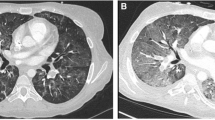Abstract
Two children, aged 3 1/2 and 5 1/2 years, are described. Both developed pulmonary oedema (PE) following a short episode of choking on a sweet and an orange, respectively. On admission diagnosis was made by chest X-ray. One child was asymptomatic despite PE while the other showed only mild respiratory distress. Both children recovered spontaneously and chest X-rays showed a return to normal within 24 h. The mechanism of PE production is discussed. It is suggested that oedema formation occurs during the obstruction and that it is due to hypoxia and the severe negative pleural pressure resulting from attempts to inspire against the obstructed airway. both hypoxia and severe negative pleural pressure cause an increase in pulmonary capillary pressure and transduration of fluid across the capillary membrane.
Similar content being viewed by others
Abbreviations
- PE:
-
pulmonary oedema
- UAO:
-
upper airway obstruction
References
Capitano MA, Kirkpatrick JA (1973) Obstructions of the upper airway in children as reflected on the chest radiograph. Radiology 107:159–161
Galvis AG, Stool SE, Bluestone CD (1980) Pulmonary edema following relief of acute upper airway obstruction. Ann Otol 89:124–128
Macartney FJ, Panaday J, Scot O (1969) Cor pulmonale as a result of chronic nasopharyngeal obstruction due to hypertrophied tonsils and adenoids. Arch Dis Child 44:585–592
Newton-John H (1977) Pulmonary oedema in upper airway obstruction. Lancet (Letter) II:510
Oswalt CH, Gates GA, Holmstrom FM (1977) Pulmonary edema as a complication of acute airway obstruction. JAMA 238:1833–1835
Recavarren S (1966) The pre-terminal arterioles in the pulmonary circulation of high altitude natives. Circulation 33:177–180
Scharf SM, Brown R, Tow DE, Parisi AF (1979) Cardiac effects of increased lung volume and decreased pleural pressure in man. J Appl Physiol 47:257–262
Soliman MG, Richer P (1978) Epiglottitis and pulmonary edema in children. Can Anaesth Soc J 25:270–275
Stalcup SA, Mellins RB (1977) Mechanism forces producing pulmonary edema in acute asthma. N Eng J Med 297:592–596
Theodore J, Robin ED (1975) Pathogenesis of neurogenic pulmonary oedema. Lancet II:749–751
Travis KW, Todres ID, Shannon DC (1977) Pulmonary edema associated with croup and epiglottitis. Pediatrics 59:695–698
Author information
Authors and Affiliations
Rights and permissions
About this article
Cite this article
Sofer, S., Bar-Ziv, J. & Mogle, P. Pulmonary oedema following choking: report of two cases. Eur J Pediatr 143, 295–296 (1985). https://doi.org/10.1007/BF00442304
Accepted:
Issue Date:
DOI: https://doi.org/10.1007/BF00442304




